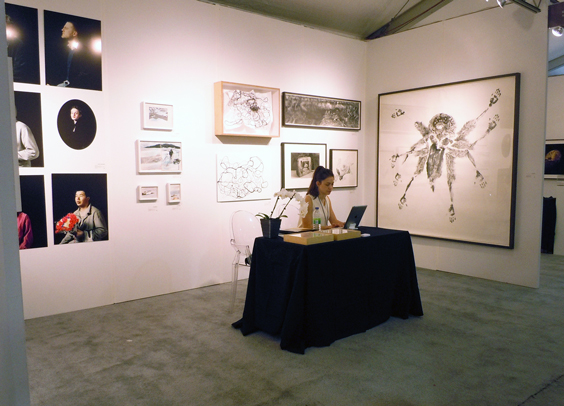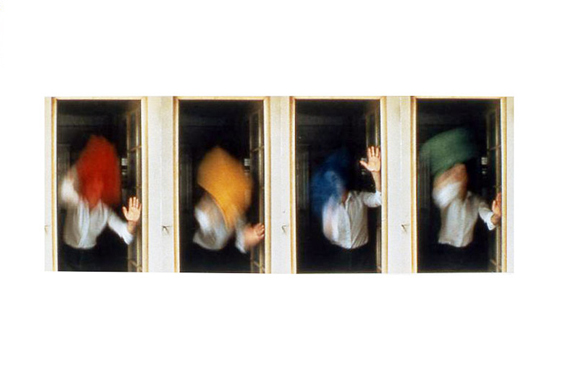
Donald Browne Gallery booth at Papier 14. Courtesy Galerie Donald Browne, Montreal
Papier 2014 set up its art fair tent this year on a vacant lot in downtown Montreal, one block away from the city’s centre point at corner of Ste-Catherine and Clark streets. Organised by AGAC (Association des Galleries d’Art Contemporain – The Association of Contemporary Art Galleries), the fair comprises a total of 44 commercial galleries from across Canada, exclusively selling works on paper. Donald Browne has been an exhibitor at Papier with his own gallery since its first edition in 2007, and acted as AGAC’s treasurer and member of the executive council for the past four years. He exchanges a few words with M-KOS about Papier 2014.
MKOS: Have you been participating in Papier since it started?
Donald Browne [DB]: Well, I’ve been a part of organizing the fair since the last four years, but yes I’ve been doing Papier with my gallery since seven years ago, when we were just 18 galleries at Westmount Square. We just had a table and a billboard behind us. It was very simple. But then when we started to get a little more confident, with a little grant from the Quebec government, and now it’s much more feasible to put on an event like this. In 2007 it was a very initial attempt at an art fair in Montreal, and with a snowball effect we finally arrived in a tent like this with 44 galleries. It’s really grown over the last seven years, I really encouraged that we have this kind of event here, it’s important for people, for the social interaction, as well as for people understanding that these things are for sale, and it’s an exciting event to prepare for.
MKOS: So this is a specialised fair, only focused on work on paper. How did that decision come about?
DB: That’s one of the challenges with this fair, but it’s also exciting to find works on paper that are interesting. Only having works on paper makes for a cohesive booth, where you can have similar aesthetics, and ideologies. I’m a gallerist who really looks for artists that have similar ideas, so this year I chose a lot of artist that dealt with gesture in creating an artwork. So you have the shape of a gesture by Sorel Cohen, washing a window as an abstract expressionists would paint canvases, then Jim Hollyoak using his body as gesture, doing body prints, covering his body in ink and pressing it on the paper and drawing an animal around it. I think people interact with paper in a very immediate way and that’s the sort of works I try to choose from.
MKOS: And I suppose having paper as the only supporting material throughout the fair also helps your booth be consistent with all the other booths. But is that the only restriction for Papier?
DB: The other thing we do in this fair is that every booth is exactly the same size. If you go to fairs around the world, people have very large booth, some have very small booths, but this is an equal opportunity space where each gallery, whether you have millions of dollars in sales, or fewer, everyone is given the same space and you’re there to defend it. So it really affects the hierarchy that you sometimes see in the contemporary art world. And it’s really nice that way.

Sorel Cohen, Shape of a gesture, 1979. Ektacolor prints on paper mounted on foamcore. Courtesy the artist and Galerie Donald Browne, Montreal
MKOS: Can you tell us more on how did Papier evolved over the years?
DB: We started with just Montreal galleries. AGAC was basically a Quebec centred group. But we decided to grow out from this territory and see what we could do and so we had a few galleries come in from Toronto, then last year we had galleries from Calgary, Edmonton and Halifax, and now we have had such good press and positive feedback that we received applications from all across Canada. It’s been really quite exciting to see it grow and develop, and also have an opportunity to educate the Montreal public about the commercial art world, and the different layers of quality that galleries can offer. Papier will give a wide spectrum of works for people to see and the best way to learn about art is to see lots of it. Some things you’ll love some things you’ll be less interested in, but just in that process you’ll develop your own taste of what you love in art and what you’re less interested in. So it’s a real feast for the eyes. If something catches your eye it will stay in your memory and if you remember something you might think of acquiring it. So that’s the role of the art fair and when you have a wider cross-section of galleries across Canada, it just makes the experience even richer.
MKOS: And do you think having it on paper will make it more accessible in term of their affordability?
DB: The price points are different. On paper, I have drawings at $8500, going down to $400, so I think they are accessible. Whereas in Toronto, when you do these big fairs, your booth is so expensive you have to put your most expensive pieces up to make it viable. So [Papier] gives a wide range of price points for people, of course you can spend a lot of money or you can just spend $400 and still get something quite beautiful, hand made and very authentic, an authentic piece of artwork.
MKOS: You also have important private patrons now partnering with Papier, like Banque Nationale as well as individual enterpreneurs.
DB: We’re a developing commercial market in Montreal we don’t have a lot of big name collectors, who frequent galleries in Montreal. We’re getting a few people here and there who are in the very wealthy circles, and can promote the collecting of art. We’re quite a bit further behind from many parts of the world, collecting art is quite the thing to do in London, New York and many others across the world. In Quebec, it’s not on the board yet, as a philanthropic thing to do. But by buying an artwork you’re supporting the artist, especially if you buy from a gallery. When you buy an artwork directly from an artist, you pay their next month’s rent, but when you buy an artwork from a gallery, you’re also ensuring that in a few months that artist will have another show. Art galleries don’t do it for the money, we do it for the promotion of the artist so we’re just continually re-investing the money so that their career can go farther, and they can further explore their metier.
MKOS: What’s the next big thing for AGAC?
DB: We’re organising Feature Art Fair in Toronto, we have a good team who are very good at organising these things, so we’re going to do a first attempt during the Toronto Art Fair. We’re going to do another very small fair with 20 galleries. As for Papier, it’s an ongoing project, developing more so next year we’re getting an even bigger tent year. It’s important that these event re-occur because people get into the habit of going to art fairs and buying art. It can be quite assuring when you get a real artwork, the actual transaction of getting an artwork is something that belongs to you. Remembering that you bought it here at Papier; that’s what becomes very exciting for collectors. ◼︎
Interviewed by Oli Sorenson
Galerie Donald Browne
#528, 372 Ste-Catherine West
Montreal, Quebec
H3B 1A2 Canada
galeriedonaldbrowne.com

